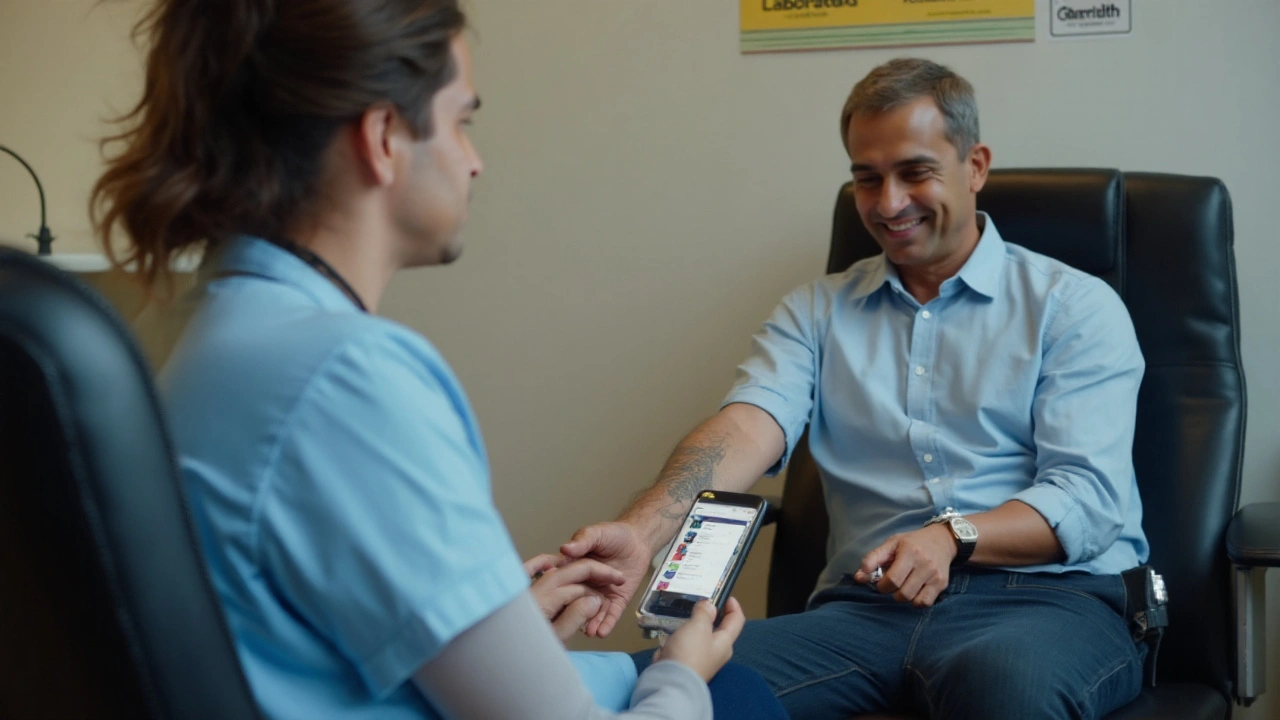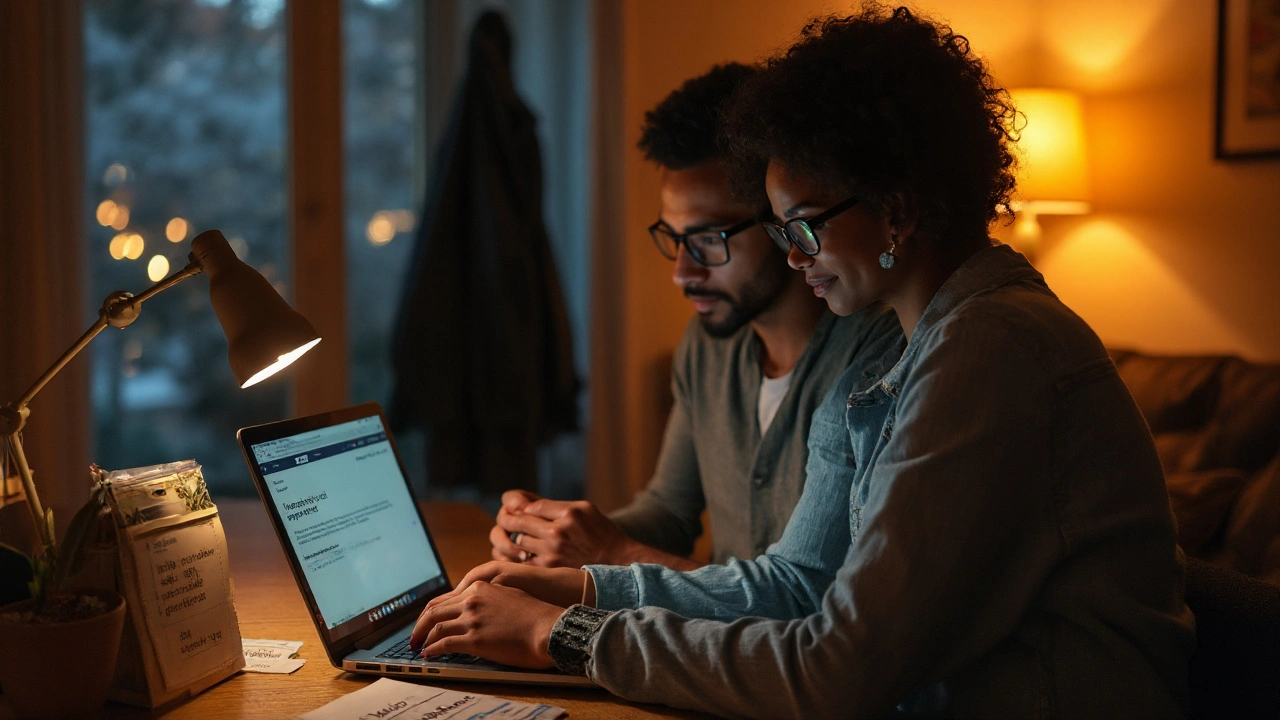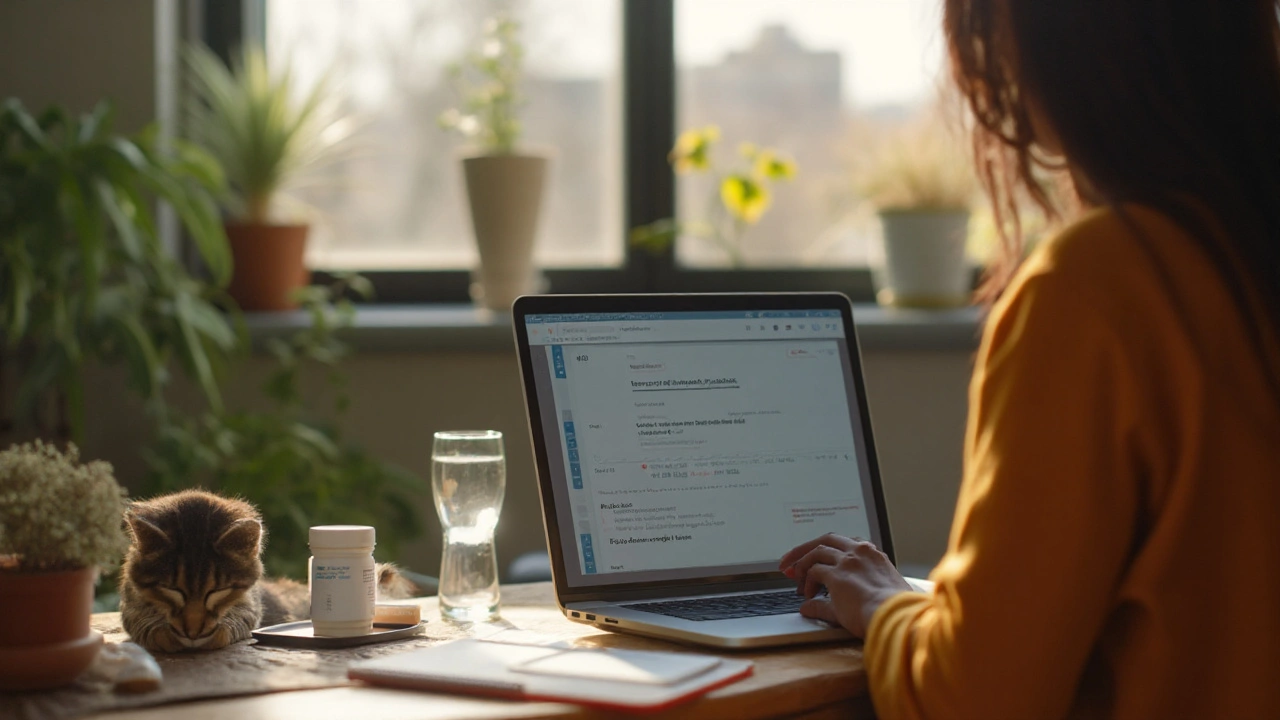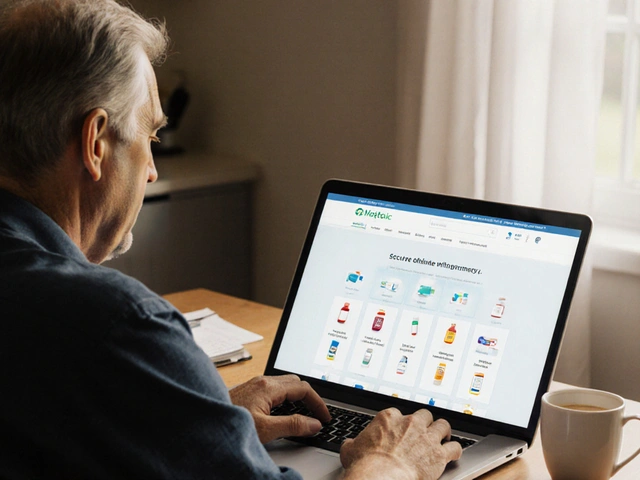You want the stability Lurasidone can bring without turning your life into a waiting room. Here’s the good news: most of the work-starting, monitoring, adjusting, refilling-can happen from your couch. The flip side? Some checks still need real-world visits. I’ll walk you through what telemedicine can handle, what can’t be skipped in person, and the smart routines that keep you safe and on track.
- TL;DR
- Yes, you can start and manage Lurasidone telemedicine care from home; it’s not a controlled drug, so e‑prescribing is routine.
- Take it with at least 350 calories. No grapefruit. Watch for akathisia (restlessness) and sleepiness early on.
- Most follow-ups work great on video; you’ll still need vitals and labs a few times a year in person.
- Have a simple data plan: weight, sleep, mood, side effects. Share updates at each tele-visit.
- If you’re severely unstable, suicidal, or having serious side effects, switch to urgent in-person care fast.
What Lurasidone Is and What Telemedicine Can (and Can’t) Do
Lurasidone (brand: Latuda) is an atypical antipsychotic used for schizophrenia and for bipolar depression in adults and adolescents. It’s known for a lighter metabolic footprint compared with some peers, but it can cause restlessness (akathisia) and sleepiness, especially early on. The FDA label is clear on two practical rules: take it with at least 350 calories for proper absorption, and avoid strong CYP3A4 inhibitors/inducers (think ketoconazole or rifampin). Grapefruit? Also a no. According to the FDA Prescribing Information (revised 2023), dose adjustments are needed with certain other meds and with moderate liver or kidney impairment.
Where does telemedicine fit? Psychiatry lends itself well to video visits. For Lurasidone specifically, telemedicine can cover evaluation, shared decision-making, e-prescribing, side-effect checks, dose tweaks, cognitive and mood assessments, caregiver input, and coordination with your primary care for labs. You don’t need a physical exam to start in many cases, though having one baseline visit (vitals and labs) makes the plan sturdier.
What still needs to be done in person? A few things: blood pressure, weight, waist circumference, labs like fasting glucose/A1c and lipids for metabolic monitoring, and an occasional in‑person AIMS exam if you’re at higher risk for movement disorders. You can do vitals at a pharmacy clinic or with your primary care team. Some people use a home scale and blood pressure cuff-great for weekly tracking, not a full replacement.
Is telemedicine “as good” as clinic visits? Several reviews (including a 2022 Cochrane review of telepsychiatry) found similar outcomes for satisfaction and symptom control when visits are structured and patients have access to labs and crisis care. The American Psychiatric Association’s 2020 schizophrenia guideline also supports remote care when safety and monitoring are handled. Telemedicine is a tool; results come from a tight routine, clear communication, and fast escalation when things turn.
Who’s a good candidate for starting Lurasidone via telehealth? If your symptoms are moderate and you have a stable living situation, video is often fine. If you’re actively suicidal, acutely psychotic without support, or missing meds due to confusion or homelessness, start in person or within a coordinated care setting. Telemedicine shines when you can keep appointments, use a phone or laptop reliably, and get to a lab when needed.
Regulatory notes for 2025 (US): Lurasidone is not a controlled substance, so DEA telemedicine rules around controlled meds don’t apply. The public health emergency flexibilities for controlled substances were extended through 2025, but that’s more relevant to stimulants or benzodiazepines. For you, the key is state licensure: your prescriber typically must be licensed where you’re located during the visit. HIPAA rules still apply; HHS guidance (updated 2024) allows compliant platforms and encourages privacy safeguards like private spaces and headphones.

Step-by-Step: Starting and Managing Lurasidone From Home
I’m big on checklists because they prevent the “I’ll do it later” spiral. Use these before your first video visit and keep them handy for follow-ups.
- Pre‑visit checklist
- Write your top three symptoms and how they affect daily life (sleep, work, relationships).
- List current meds and supplements. Highlight any antibiotics, antifungals, seizure meds, or herbal products like St. John’s wort.
- Collect recent vitals if you can: weight, blood pressure, heart rate. A pharmacy kiosk works.
- Bring recent labs if available: fasting glucose or A1c, lipids, liver function.
- Decide who joins the call: a partner or parent can add useful observations.
- First appointment game plan
- Expect a symptom review, medical history, and a risk check (suicide, agitation, substance use).
- Discuss dosing targets based on your diagnosis. For schizophrenia, many adults start at 40 mg once daily with food; for bipolar depression, 20-40 mg is common, titrated by effect and side effects. Your clinician will individualize this based on the FDA label and guidelines.
- Agree on lab timing. If you haven’t had recent labs, schedule them within the first month.
- Get a side-effect action plan (more below). If you feel stuck or scared between visits, you need a clear number to call and a plan for urgent care.
- How to take Lurasidone the right way
- Always with a meal of at least 350 calories. A turkey sandwich plus yogurt works; a single apple does not. Food increases absorption severalfold.
- Avoid grapefruit and juice. It can spike blood levels.
- Stick to a consistent time. Evening is common if you get drowsy.
- If you miss a dose and it’s the same day, take it with food when you remember. If it’s the next day, skip the missed dose-don’t double up.
- Early side effects and quick fixes
- Akathisia (restlessness): feels like you can’t sit still. Rates in trials run about 10-15%. Call your prescriber early; small dose changes, dose timing, or adding propranolol can help.
- Sleepiness: often fades after 1-2 weeks. Shift the dose to evening or tweak the dose if needed.
- Nausea: take with a larger meal; ginger tea or anti-nausea meds short-term can help.
- Stiffness or tremor: less common, but tell your prescriber quickly-movement side effects are easier to fix if caught fast.
- What to monitor at home between tele-visits
- Weight weekly for the first month, then monthly. Lurasidone is relatively weight-neutral versus some antipsychotics, but don’t assume-your body writes its own story.
- Sleep hours and quality. A quick note in your phone each morning is enough.
- Mood and energy. Use a 0-10 scale. If your bipolar depression score is stuck under 4 after 2-4 weeks at a therapeutic dose, tell your prescriber.
- Side-effect diary: one line a day. Patterns jump out in two weeks.
Here’s a simple care plan timeline you can share with your clinician. It blends tele-visits with smart, minimal in‑person touchpoints.
| Timepoint | Telemedicine tasks | In-person tasks | Why it matters |
|---|---|---|---|
| Week 0 (Start) | Video evaluation, shared decision, e‑Rx, food/interaction counseling | Optional if recent labs exist | Get a safe, personalized starting plan |
| Week 1-2 | Check side effects (akathisia, drowsiness), adjust dose/timing | - | Most early tolerability issues appear now |
| Week 4 | Symptom response review, functional goals, adherence check | Vitals; labs if not done yet (glucose/A1c, lipids) | Baseline metabolic profile and early efficacy |
| Week 8-12 | Fine-tune dose; address residual symptoms | Repeat vitals if concerns | Solidify the maintenance plan |
| Every 3-6 months | Video follow-up; monitor mood, cognition, side effects | Vitals, labs as indicated; periodic AIMS exam if needed | Catch metabolic or movement issues early |
| Anytime | Portal messages for questions; refill requests | Urgent care/ER if severe symptoms | Fast help beats waiting it out |
Rules of thumb I use with patients:
- If side effects are mild but improving by week 2, ride it out and reassess at week 4.
- If restlessness is moderate or worse and not improving after a few days, send a message-early tweaks prevent dropout.
- If depression hasn’t budged by week 4 at a reasonable dose, consider a dose increase or combination therapy per CANMAT/ISBD updates (2023).
- A 5-7% weight gain from baseline is a cue to recheck the plan, diet, activity, and meds.
Drug interactions to respect:
- Strong CYP3A4 inhibitors (e.g., ketoconazole, clarithromycin) are contraindicated; in practice, your prescriber will pick another antibiotic/antifungal.
- Strong CYP3A4 inducers (e.g., rifampin, carbamazepine, phenytoin) can drop levels too low-avoid or adjust therapy.
- Moderate inhibitors (e.g., diltiazem) often require dose adjustment; this is straight from the FDA label.
- Alcohol and sedatives can add to drowsiness-use caution.
Special dosing notes (don’t self-adjust): For adults with schizophrenia, common targets range 40-80 mg daily; for bipolar depression, 20-120 mg based on response. Adolescents typically use lower starting doses. In moderate hepatic or renal impairment, lower maximums apply. Your clinician will tailor this-your job is to report accurately how you feel.

Staying Covered, Safe, and Connected via Telepsychiatry
Let’s talk logistics, because they make or break consistency.
Insurance and prior auth: Many plans require prior authorization for Latuda. You can speed it up by uploading past trial-and-failure meds, intolerance notes, and your diagnosis to the portal. Ask your clinician to send the e‑Rx to a pharmacy that reliably stocks it; some retail chains need a day to order. If your copay is high, manufacturer savings cards can help commercially insured patients; state programs vary. Mail-order pharmacies can be cheaper but slower on the first fill-consider local for the first month, then switch if costs make sense.
Refills without drama: Request refills when you have 7-10 days left. If your dose might change, ask for a 30‑day supply until you stabilize. Once steady, 90‑day supplies reduce pharmacy trips and copays.
Privacy and tech setup: Use headphones, sit with your back to a wall (no one wandering behind you), and keep a small notepad in view. Position your camera at eye level so your clinician can see facial movement-useful for picking up subtle side effects. Close other apps. If your Wi‑Fi is spotty, switch to cellular data or move closer to the router. For meds like Lurasidone, where nuanced observation matters, video beats phone calls.
Legal basics (US, 2025): Your clinician typically must be licensed in the state where you sit during the visit. If you travel, tell the office beforehand-they may not be able to see you across state lines. HIPAA‑compliant platforms are the norm; free consumer apps used during the pandemic waivers are mostly out of bounds now except under specific allowances. If someone is recording the session (you or the clinician), that must be disclosed and documented.
When video isn’t enough: If hallucinations intensify fast, if you can’t keep food down (so you can’t take the medication properly), if you’re pacing all day from restlessness, or if suicidal thoughts get specific, step out of telemedicine and into urgent care or ER. Video is a window, not a safety net.
Caregiver playbook: A partner or parent can join the first two visits and any visit where things are slipping. Ask them to watch for pacing, leg shaking, or new agitation after dose changes. Their one-minute summary at the start of the visit can save you 10 minutes of back-and-forth.
Checklist: Your Home Lurasidone Kit
- Digital scale and, if possible, a blood pressure cuff
- Weekly tracker: weight, sleep hours, mood 0-10, side effects
- Meal plan for dose timing (350+ calories ready at the usual hour)
- Pharmacy on file that stocks Latuda
- Emergency plan: who to call, where to go
Frequently asked questions
How fast does Lurasidone work?
Some people notice calmer thinking or less anxious depression in 1-2 weeks. Full mood benefits may take 4-6 weeks at a stable dose. If there’s zero movement by week 4, ping your clinician.
Is weight gain a big risk?
Compared with olanzapine or quetiapine, Lurasidone has a lower risk of weight gain and metabolic issues in trials. Still, some gain weight. The weekly scale check tells the truth faster than feelings do.
Can I drive on it?
See how it affects you first. Early drowsiness can be real. If you feel sedated, shift dosing to evening and avoid driving until you know your baseline.
Can I take it during pregnancy?
Discuss risks and benefits with your prescriber and OB. Data are limited; untreated illness also carries risks. Shared decision-making is key here.
What about teens?
Approved for schizophrenia and bipolar depression in adolescents. Start low, go slow, and involve parents/guardians. Schools can help track function and mood.
Do I need routine EKGs?
Lurasidone has a relatively low risk of QT prolongation, but if you have heart disease, are on QT‑prolonging meds, or have electrolyte issues, your clinician may order one.
What if I’m also on antidepressants or mood stabilizers?
Common combinations are fine. Watch for additive drowsiness or interactions. The CANMAT/ISBD bipolar guidelines support combination strategies when monotherapy isn’t enough.
How do I know if akathisia is the issue?
It feels like internal motor restlessness-pacing, shifting in your seat, a “need to move” feeling that doesn’t match anxiety. Report it early; it’s fixable.
Can I switch to another antipsychotic if needed?
Yes. Cross-tapering plans depend on the target drug and your symptom control. Do not stop abruptly unless directed for safety reasons.
Next steps
- Book a tele-visit. Ask for a 30‑minute slot for starts or restarts.
- Schedule labs within 2-4 weeks if you don’t have recent results.
- Set a daily alarm titled “Lurasidone + 350 calories.”
- Create a one-line daily note in your phone: mood, sleep hours, side effects.
- Tell one trusted person your plan and how to help if you wobble.
Troubleshooting by scenario
- “I feel wired and can’t sit still.” That’s likely akathisia. Message your clinician today. Ask about dose timing, a small dose reduction, or adding a short-term beta‑blocker.
- “I forget doses.” Tie it to dinner, set a phone alarm, and keep the pill bottle near your plate. Consider a weekly pill organizer.
- “I can’t eat 350 calories at bedtime.” Move the dose earlier to the meal where you do eat enough. Consistency beats ideal timing.
- “Pharmacy is out of stock.” Ask your prescriber to send to a different chain or a 24‑hour location. Call ahead the day before you run out.
- “My video keeps freezing.” Switch to phone data, turn off HD video, or ask for an audio‑first visit with a quick photo upload of any logs or readings.
Why trust these steps? They’re anchored to the FDA Prescribing Information for lurasidone (Latuda), the APA Practice Guideline for the Treatment of Patients With Schizophrenia (2020), and CANMAT/ISBD guidance for bipolar depression (latest updates reflected through 2023). The telemedicine pieces track with HHS HIPAA telehealth guidance (2024) and current state licensure norms. Randomized and meta‑analytic reviews of telepsychiatry (including Cochrane 2022) show comparable outcomes to in‑person care when monitoring and escalation plans are baked in. That’s the backbone. Your lived experience and daily data are the muscle.
I’m Paul, and I’ve helped a lot of people build simple, sturdy routines around complex meds. You can absolutely do this from home-with a plan, a scale, a reliable meal, and a team that replies when you need them.
Educational use only. Talk with your clinician for personalized medical advice.





17 Comments
Louis Antonio
Alright, so you can start Latuda via video, but don't think the digital couch replaces every in‑person check. The food rule isn’t a suggestion – it’s in the FDA label, so you’ll need a real meal, not a snack, before each dose. Labs aren’t optional; they’re the safety net that keeps the medication from doing you harm down the line. Also, the whole “no controlled substance” thing means e‑prescribing is easy, but you still need a licensed prescriber in the state you’re physically located. Bottom line: telehealth works, but it works because you follow the protocol, not because it’s magic.
Kyle Salisbury
Interesting points, thanks for sharing.
Angie Robinson
Let me break down why this whole telemedicine hype is overblown for a drug like Lurasidone. First, the guide pretends that a video call can replace the nuanced assessment of movement disorders – you can’t eyeball tardive dyskinesia through a grainy webcam. Second, the emphasis on “most follow‑ups work great on video” ignores the reality that many patients lack stable internet, a private space, or the discipline to record vitals accurately. Third, the checklist is a nice idea, but it assumes everyone has a digital scale and blood pressure cuff on hand, which is not the case for low‑income or rural users. Fourth, the guide downplays the risk of akathisia; early restlessness can quickly spiral into severe agitation, and waiting for a tele‑visit to notice that is a recipe for crisis. Fifth, the suggestion that you can skip in‑person labs for a few months is reckless – metabolic changes can be silent until they become dangerous. Sixth, the legal section glosses over licensure complexities; a provider in New York cannot legally see a patient sitting in Texas, and that barrier is not trivial. Seventh, insurance prior‑auth for Latuda is notoriously slow, and the guide’s “upload past meds” advice is insufficient without a dedicated care coordinator. Eighth, the “emergency plan” is vague – a true safety net includes a 24‑hour crisis line, not just “who to call.” Ninth, the advice to “take with 350 calories” is buried under a paragraph, whereas it should be a headline warning; forgetting that dose can render the medication ineffective. Tenth, the guide assumes you have a supportive caregiver who can monitor you, which many patients simply do not have. Eleventh, the suggested schedule for labs at week 4 and then every 3‑6 months ignores the need for more frequent monitoring in patients with comorbid diabetes or dyslipidemia. Twelfth, the mention of “no grapefruit” is too brief; the interaction is significant and can cause dangerous spikes in blood levels. Thirteenth, the tone is overly optimistic, bordering on promotional, without adequately stressing the need for close collaboration with a primary care doctor. Fourteenth, the guide fails to address polypharmacy concerns when Lurasidone is combined with mood stabilizers or antidepressants. Fifteenth, the suggested use of a “home scale” is unreliable unless calibrated regularly. Sixteenth, the recommendation to use video instead of phone calls neglects patients with visual impairments. Seventeenth, the entire piece neglects cultural considerations – dietary habits, health literacy, and trust in telehealth vary widely. Overall, the guide is a well‑intentioned checklist, but it skirts many practical, safety, and equity issues that can’t be solved with a simple markdown table.
Patrick Hendrick
Hey, I hear you, and I get why you’re wary – safety first, always. 💡 Let’s keep the good parts (the step‑by‑step) and tighten the gaps you highlighted. If you add a quick note about a 24‑hour crisis line and a reminder that labs might need to be sooner for certain comorbidities, the guide becomes way more robust. 👍
Mimi Saki
Great rundown! 🙂 I’ve been on Latuda for a few months and the meal rule saved me from a lot of nausea. The weekly weight check is simple if you have a digital scale – just step on after your morning coffee and jot it down. Keep sharing these tips, they help a lot of us who are navigating tele‑psychiatry.
Subramaniam Sankaranarayanan
From my experience, the checklist approach is sound, but it needs a moral compass: patients must understand that skipping labs is not a matter of convenience but a duty to themselves. The food requirement isn’t a trivial detail; it’s pharmacokinetics. Moreover, prescribing across state lines without proper licensure is ethically dubious and can jeopardize care continuity. Also, insurance navigation is often a maze that the guide treats too lightly. Lastly, the guide could stress the importance of informed consent about tele‑medicine limits – patients deserve that transparency.
Kylie Holmes
Exactly! 🎉 Stick to the plan and you’ll avoid a lot of hiccups. If you miss a dose, just reset with your next meal – no panic.
Jennifer Wees-Schkade
Let’s cut to the chase: the protocol is solid, but the language must be crystal‑clear. Emphasize that the first in‑person labs are non‑negotiable and that any sign of akathisia warrants an immediate call, not a wait‑until the next video. Also, spell out the exact steps for an urgent care referral – patients need a phone number, not a vague “call your doctor.” Lastly, don’t forget to mention that if the pharmacy is out of stock, the prescriber should switch to a generic if possible and notify the insurer.
Fr. Chuck Bradley
Whoa, drama alert! 😱 It’s like reading a thriller where the hero forgets his own medication schedule. But seriously, the urgency can’t be overstated – a missed lab can turn a quiet night into a nightmare.
Patrick Rauls
Yo, this guide is lit! :) Just make sure you got a decent internet conn and a backup plan if the video drops. Also, keep an eye on those side‑effect logs – they’re gold when you chat with your doc.
Asia Lindsay
Thanks for the thorough outline! 🤗 I love the daily tracker tip – it helped me notice a pattern with my sleep that I’d missed otherwise. Keep the emojis coming, they make the info feel friendly.
Angela Marie Hessenius
From a cultural standpoint, the guide does well to acknowledge the need for a stable living situation, but it could deepen its relevance by addressing diverse dietary patterns that affect the 350‑calorie rule. For instance, some traditions rely on lighter evening meals; suggesting alternative timing or calorie‑dense snacks would be inclusive. Moreover, the language surrounding “privacy” could incorporate advice for multigenerational households where private space is scarce. Adding a brief note on interpreter services for non‑English speakers would also broaden accessibility. Lastly, citing community resources for low‑cost labs and medication assistance could bridge the socioeconomic gap that often limits tele‑psychiatry effectiveness.
Julian Macintyre
Whilst the manuscript provides a commendable overview of telepsychiatric protocols for Lurasidone administration, it fails to adequately address the exigencies associated with inter‑jurisdictional licensure constraints, thereby risking non‑compliance with extant statutory frameworks. Furthermore, the brevity with which adverse‑event monitoring is treated is incongruous with the gravitas of the pharmacodynamic profile of the agent.
Patrick Hendrick
Great summary, concise, and practical; however, consider adding a line about emergency contacts, especially for suicidal ideation!; Also, note the importance of regular labs;.
abhishek agarwal
Listen, if you’re going to ignore the lab schedule, you’re asking for trouble; don’t be lazy about the food rule – it’s a deal‑breaker for absorption. Get serious about the plan or you’ll end up back in the clinic anyway.
Michael J Ryan
Hey folks, just a quick note – the guide is solid, but remember to double‑check your insurance prior‑auth status before the first fill. Also, keep a calm tone when discussing side‑effects with your doc; it makes the conversation smoother.
Khalil BB
Telemedicine isn’t a panacea; the real test is whether patients stick to the regimen once the screen goes dark. If adherence slips, the whole model collapses.